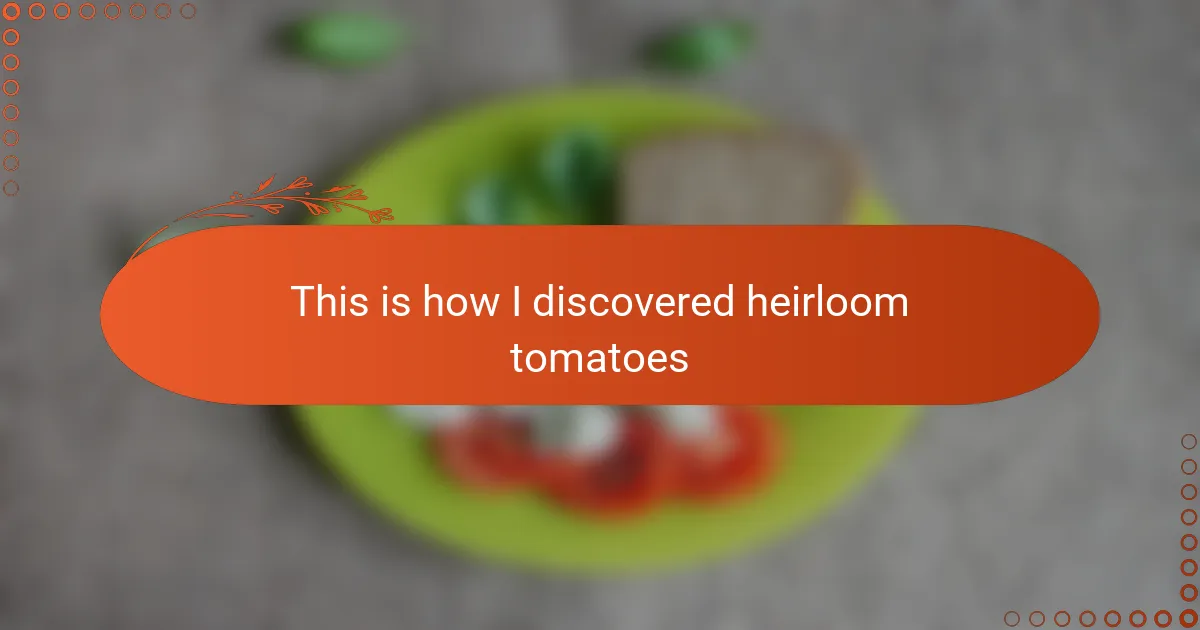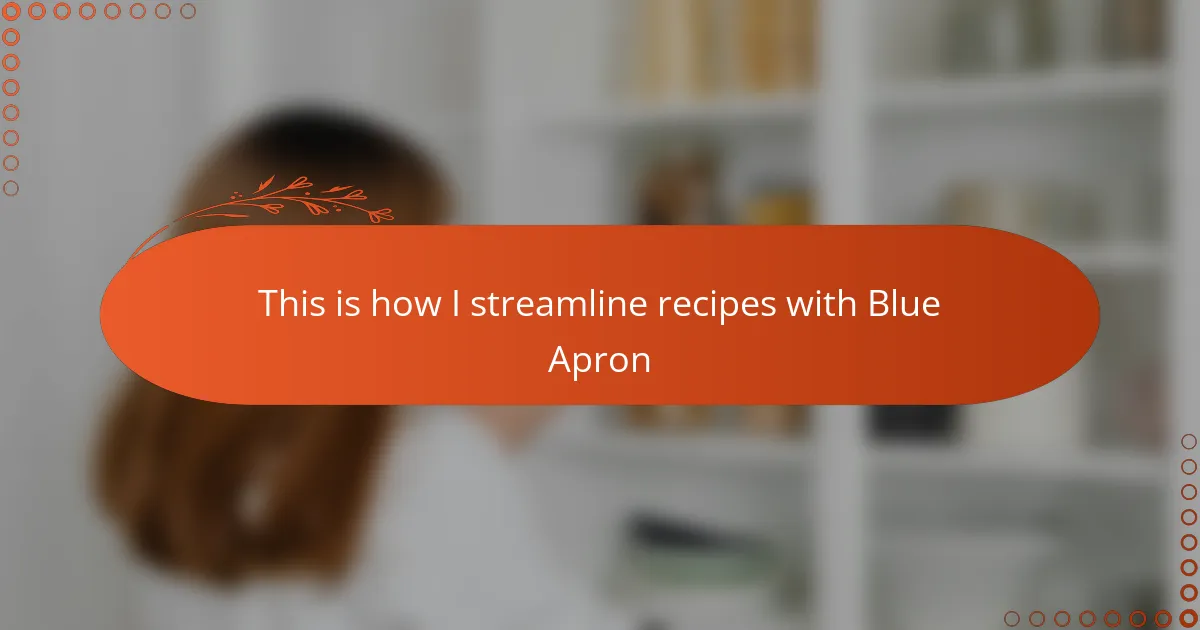Key takeaways
- Heirloom tomatoes are unique, open-pollinated varieties valued for their rich flavors, diverse appearances, and connection to tradition.
- Growing heirloom tomatoes supports sustainability and biodiversity, and the process requires more care and attentiveness than hybrid tomatoes.
- Cooking with heirloom tomatoes enhances dishes significantly, offering a range of flavors and visual appeal that transforms meals into artistic experiences.
- Personal experiences, such as discovering heirloom tomatoes at a farmers market, deepen the connection to food and its history, highlighting the joy of traditional cooking.
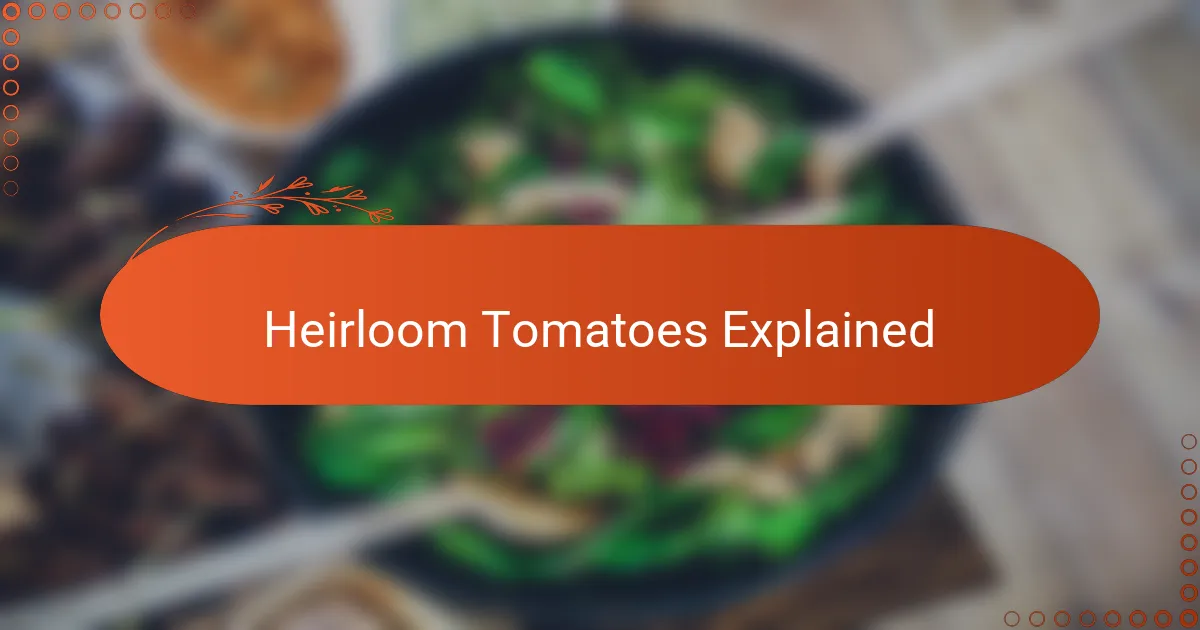
Heirloom Tomatoes Explained
Heirloom tomatoes aren’t just any tomatoes; they are varieties passed down through generations, cherished for their unique flavors and colors. I remember biting into my first heirloom tomato—its rich, complex taste was unlike the bland ones I’d grown up eating. Have you ever wondered why some tomatoes taste so much better than others?
Unlike the mass-produced tomatoes in supermarkets, heirlooms come from open-pollinated seeds. This means their seeds can be saved and replanted year after year, preserving the original plant’s unique traits. It’s like holding a piece of history in your hands, something deeply rooted in tradition and family stories.
What really fascinates me is how no two heirloom tomatoes look exactly alike—some are striped, others bumpy, some round, others oddly shaped. Their diversity is a beautiful reminder of nature’s creativity, and to me, that makes cooking with them feel more like an art than a chore. Don’t you find that special connection with food makes the whole cooking experience more meaningful?
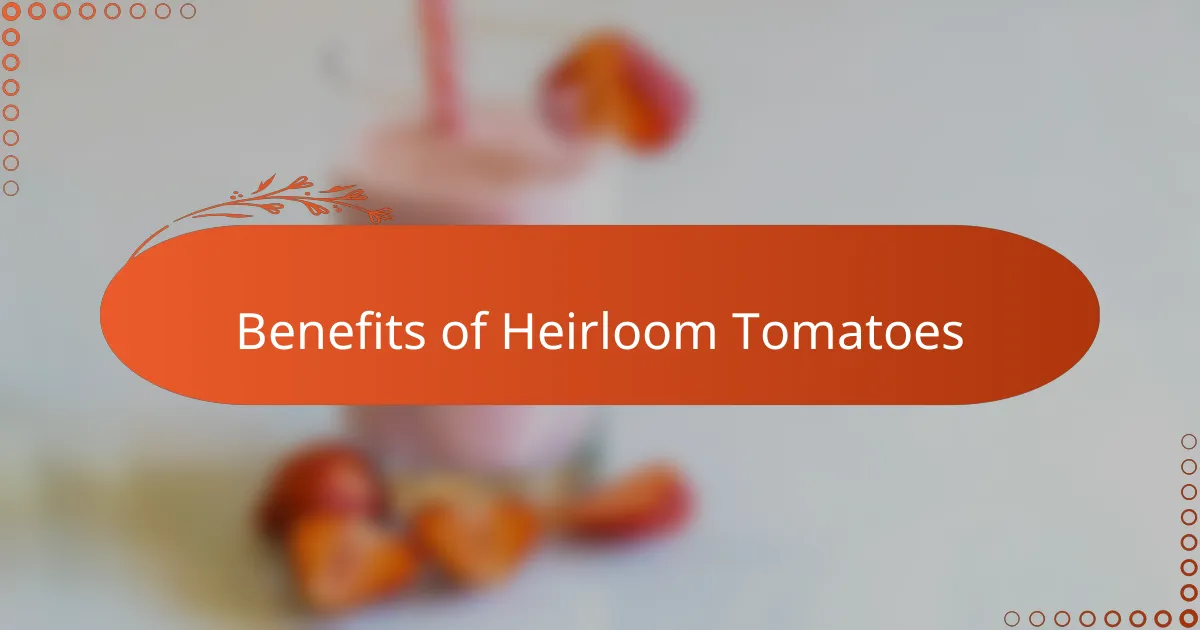
Benefits of Heirloom Tomatoes
One of the biggest benefits I’ve found with heirloom tomatoes is their incredible flavor depth. Unlike the uniform sweetness of grocery store tomatoes, heirlooms have hints of tanginess, earthiness, and even floral notes that make each bite a little adventure. Have you ever tasted something so vibrant that it makes you pause and really savor the moment? That’s what these tomatoes did for me.
Another thing I appreciate is knowing that heirloom tomatoes are often grown without heavy chemical interventions. Growing them or sourcing from small farms means supporting sustainability and biodiversity, which feels good both for the planet and for what ends up on my plate. It’s reassuring to eat something that’s connected to the earth in a more natural way.
Lastly, I can’t overlook how heirlooms add beauty to any dish. Their varied shapes and colors – from deep purples to bright yellows – brighten up salads and sandwiches like edible artwork. Isn’t it amazing how food that looks this stunning tastes even better? That little burst of color on your plate can truly lift your entire meal experience.
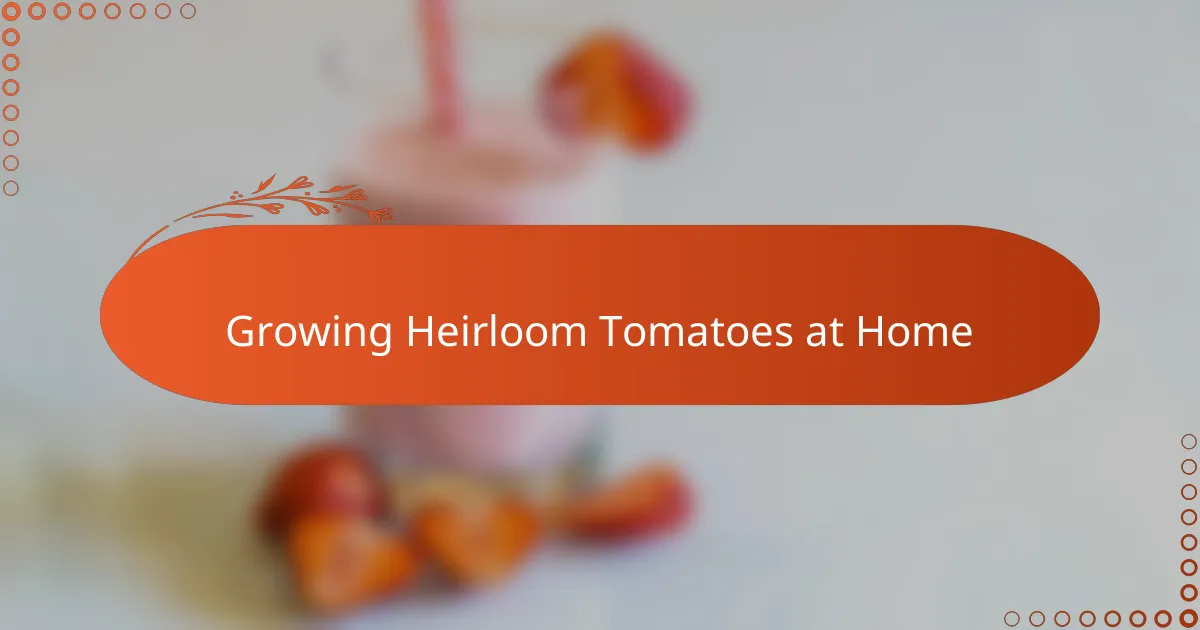
Growing Heirloom Tomatoes at Home
Growing heirloom tomatoes at home has been one of the most rewarding gardening experiences I’ve had. I love how starting from seed feels like nurturing a small piece of history right in my backyard. Have you ever watched a tiny sprout push through the soil and knew that in a few months, it would bear fruit bursting with flavor and story?
One thing I quickly learned is that heirlooms can be a bit more finicky than hybrid tomatoes. They often need a little extra attention—whether it’s staking the vines or keeping an eye out for pests. But that care creates a connection; you’re not just growing tomatoes, you’re cultivating patience and appreciation for the process.
What surprised me most was how the tomatoes’ colors and shapes varied even on the same plant. It’s like a delightful surprise every time I go out to harvest. Doesn’t it feel special to bring in a basket of produce that looks more like an artful collection than a uniform batch of fruit? That’s the charm of heirlooms that keeps me coming back season after season.
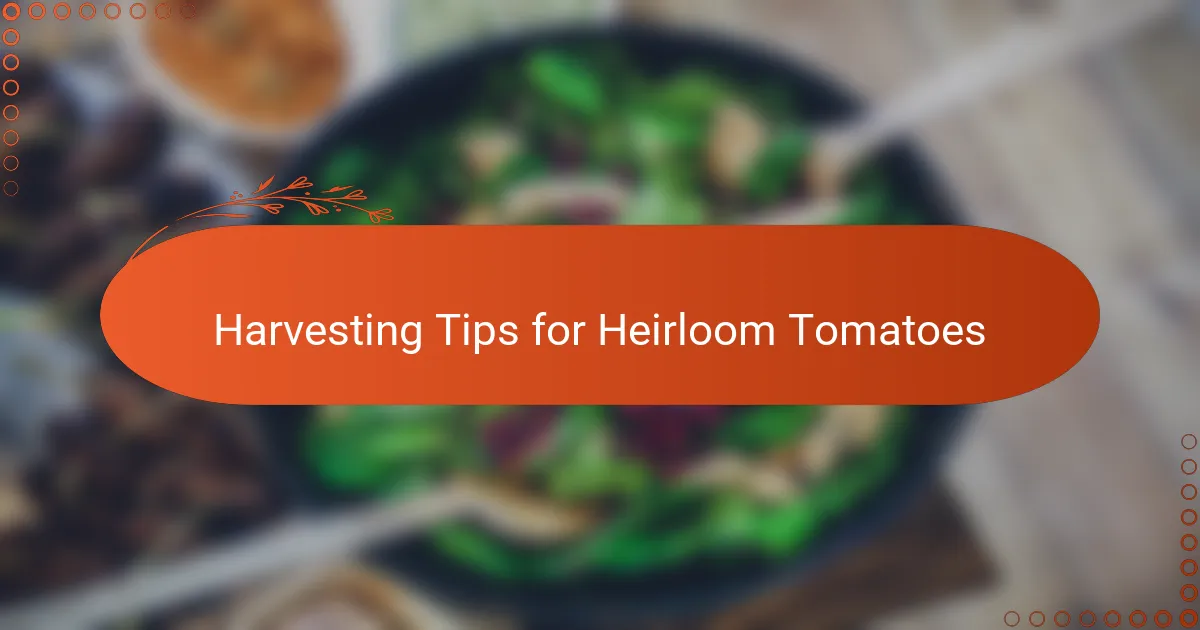
Harvesting Tips for Heirloom Tomatoes
Timing is everything when it comes to harvesting heirloom tomatoes. I found that waiting until the fruit is fully colored and just slightly soft to the touch makes all the difference in flavor. Have you ever picked a tomato too early and ended up with that disappointing bland taste? I certainly have, and it taught me to be patient and let nature do its work.
When I first started, I was unsure whether to pick tomatoes in the morning or afternoon. Over time, I realized morning harvests are best—cooler temperatures help maintain the tomatoes’ freshness and vibrant taste. Plus, picking early gives me the whole day to enjoy their sweet aroma filling the kitchen.
One thing I had to get used to was handling each heirloom tomato with care. Their delicate skins bruise easily, so I learned to gently twist or snip them off the vine instead of yanking. It’s a small effort that rewards me with fruit that lasts longer and tastes as beautiful as it looks. Don’t you love that satisfying feeling of bringing in a perfect, unblemished tomato?
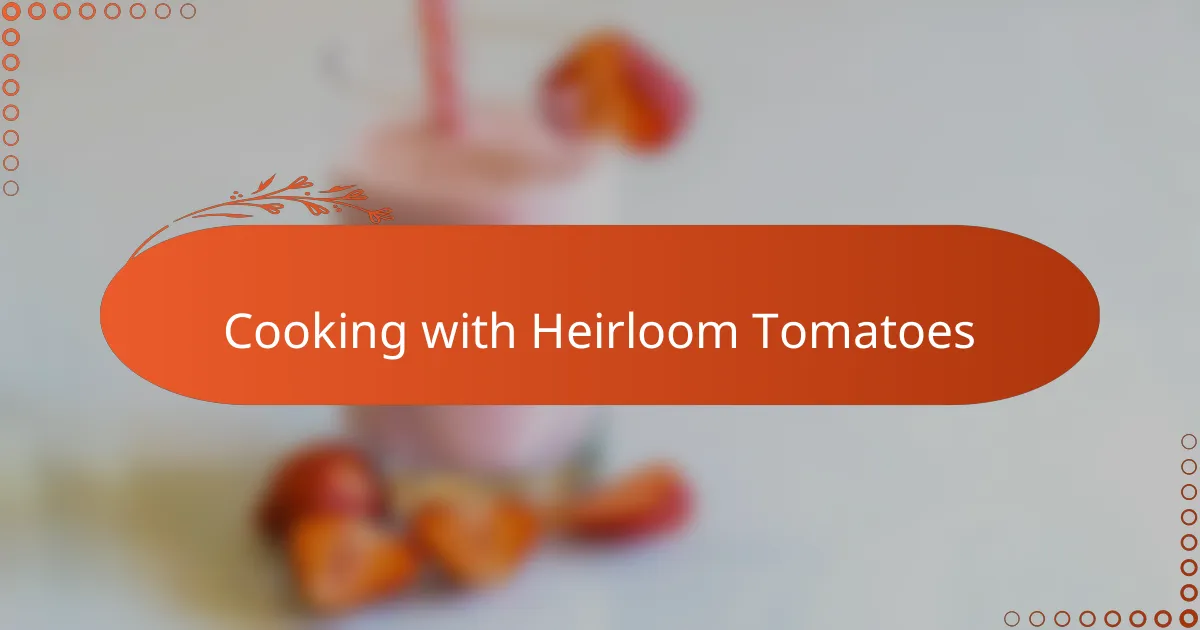
Cooking with Heirloom Tomatoes
Cooking with heirloom tomatoes feels like unlocking a secret treasure in the kitchen. Their complex flavors don’t just enhance a dish—they transform it. I remember tossing a simple salad with slices of ripe heirlooms and suddenly the whole meal tasted fresher, richer, and full of life. Have you ever experienced how one ingredient can completely change your cooking game?
What I also love about cooking with these tomatoes is their versatility. Whether I’m roasting them to concentrate their sweetness or simply layering them fresh on a sandwich, each method brings out different notes—from tangy brightness to deep, velvety richness. It makes me wonder, why settle for boring tomatoes when you can have such a sensory experience with heirlooms?
Sometimes, I just let the heirloom tomatoes shine on their own—lightly drizzled with olive oil, a sprinkle of salt, and fresh basil. The colors alone make the plate inviting, but the burst of flavor in every bite makes me grateful for discovering these gems. Don’t you think food that tastes as good as it looks is the best kind of comfort?

Personal Discovery Story
I stumbled upon heirloom tomatoes quite by chance at a local farmers market, drawn initially by their vibrant colors rather than their flavor. What struck me immediately was how different they were from the usual tomatoes I’d bought at the grocery store—their aroma alone was enough to pique my curiosity. Have you ever noticed how some foods instantly make you pause and wonder what secrets they hold?
The first time I sliced into one at home, I was blown away by the explosion of flavors—so rich and varied compared to the bland, uniform taste I’d expected. It felt like discovering a hidden chapter in a book I thought I knew well, and from that moment, I was hooked. Isn’t it amazing how a simple fruit can open the door to a whole new world of taste and tradition?
My journey with heirloom tomatoes became more than just tasting; it turned into a mission to understand and preserve these unique varieties. Growing them myself deepened that connection, as each plant told a story stretching back through generations. Don’t you think food tastes better when you know the story behind it? For me, that made heirlooms not just tomatoes but a living link to the past.
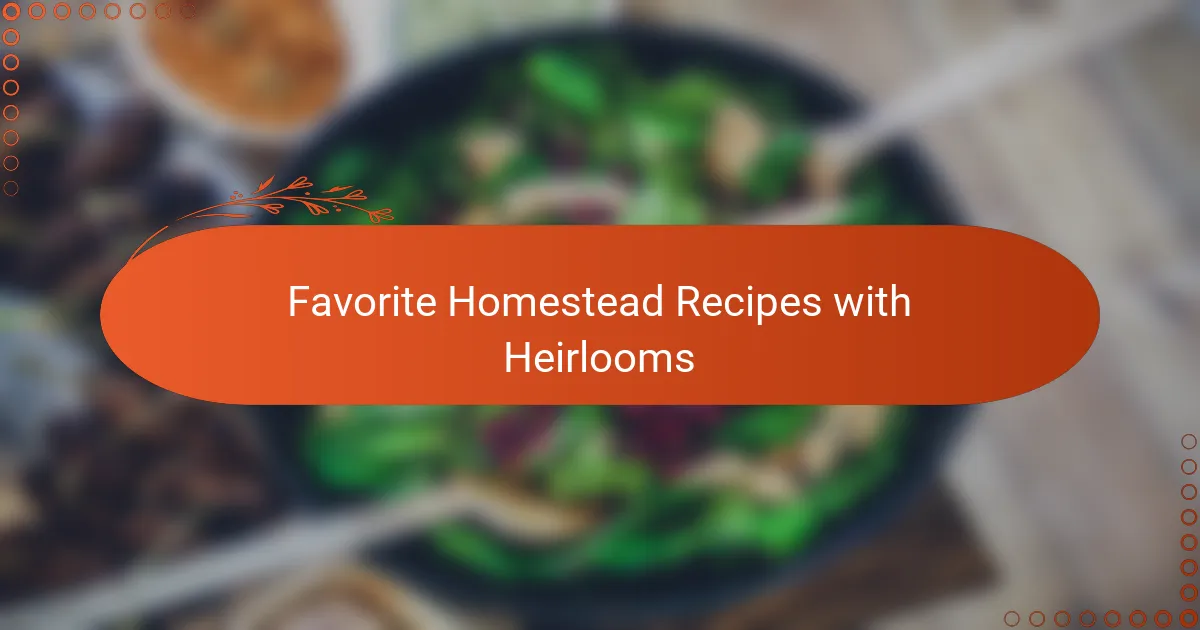
Favorite Homestead Recipes with Heirlooms
There’s one recipe I always come back to—heirloom tomato bruschetta. Just slicing those colorful tomatoes and mixing them with fresh basil, garlic, and a drizzle of olive oil feels like capturing summer in a bite. Have you ever had a dish so simple yet so full of vibrant, layered flavors that it instantly transports you to a sun-drenched garden?
Another favorite is my slow-roasted heirloom tomato sauce. The roasting process sweetens and deepens the tomatoes’ natural complexity, turning a humble pasta dinner into something deeply satisfying. I find that this recipe really lets the tomatoes tell their story, making each spoonful rich with history and heart.
Sometimes, I simply slice heirlooms thick and layer them with fresh mozzarella and basil for a classic caprese salad. It’s a dish that never fails to brighten my table and lift my mood. Don’t you think meals that celebrate fresh, natural ingredients like this connect us back to the roots of homestead cooking?
